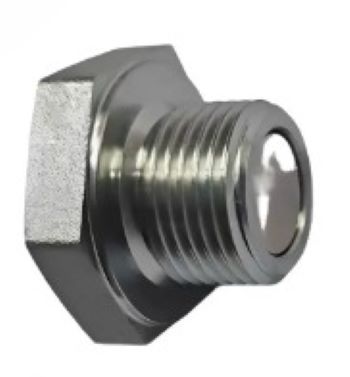Hydraulic hoses are vital to many machines. They move pressurized fluid to power everything from construction equipment to farm machinery. But what happens when those hoses aren’t in use? That’s where hydraulic hose plugs come in, playing a crucial role in keeping your systems healthy and safe.
This post covers everything about hydraulic hose plugs. It answers common questions and gives tips.
What are Hydraulic Hose Plugs?
Metric Male Captive Seal Internal Hex Plug
Hydraulic hose plugs are simple yet essential components. They are designed to seal the open ends of unused hydraulic hoses, preventing leaks and contamination. These plugs come in various types to suit different needs.
➡️ Screw-in plugs: These threaded plugs offer a secure connection for high-pressure applications. They are typically made of durable materials like steel or brass.
➡️ Push-on plugs: These plugs offer a quick and easy way to seal hoses. They are commonly made from nylon or other plastics and are suitable for lower pressure applications.
➡️ Dust caps: These lightweight caps protect hose ends from dust and debris during storage or transportation. They are often made of plastic or rubber.
The material used for hydraulic hose plugs depends on the application. Steel and brass offer superior strength for high-pressure systems, while nylon provides a cost-effective option for lower pressures.
FAQs about Hydraulic Hose Plugs
When should I use a hydraulic hose plug?
You should use a hydraulic hose plug any time a hose is not actively in use. This includes situations like:
➡️ During storage of equipment
➡️ When a hose is disconnected for repairs or maintenance
➡️ When a section of the hydraulic system is not operational
What are the risks of not using a hydraulic hose plug?
Leaving a hose uncapped can lead to several problems:
➡️ Leaks: Unplugged hoses can leak fluid, wasting valuable resources and creating environmental hazards.
➡️ Contamination: Dirt, debris, and moisture can enter the hose, contaminating the hydraulic fluid and damaging components.
➡️ Component damage: Uncontrolled flow of pressurized fluid can damage pumps, valves, and other hydraulic system parts.
➡️ Safety hazards: Leaks and uncontrolled fluid flow can create safety risks for operators.
How do I choose the right hydraulic hose plug?
Choosing the right plug involves considering several factors:
➡️ Hose size: The plug size needs to match the hose diameter for a proper seal.
➡️ Pressure rating: The plug’s pressure rating should be equal to or exceed the maximum pressure of the hydraulic system.
➡️ Material compatibility: Ensure the plug material is compatible with the hose material and the type of hydraulic fluid used.
➡️ Application: Consider factors like temperature range and vibration when selecting the material and type of plug.
For specific guidance on choosing the right plug, consult a hydraulics specialist or refer to the manufacturer’s recommendations for your hoses.
Additional Tips for Using Hydraulic Hose Plugs
1. Inspect plugs for damage before use. Cracks, chips, or worn threads can compromise the seal.
2. Use the proper tightening torque when installing screw-in plugs. Overtightening can damage the plug or hose, while under-tightening can lead to leaks.
3. Store unused plugs in a clean and dry place. This helps prevent damage and contamination.
Conclusion
Hydraulic hose plugs are a small but vital part of maintaining a healthy and safe hydraulic system. By using the right plugs and following these tips, you can prevent leaks, contamination, and costly downtime. Remember, if you have any questions about your specific hydraulic system needs, consult a qualified professional.
For more information on hydraulic hose care and maintenance, or to explore our selection of hydraulic hose plugs, contact us today!
Post time: May-22-2024


